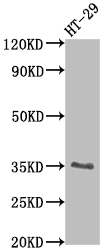The EPCAM recombinant monoclonal antibody is prepared using protein technology and DNA recombinant technology. To begin, mice are immunized with a synthesized peptide derived from human EPCAM. After a certain period, the spleen is removed from the mice under aseptic conditions, and total RNA is extracted from the spleen cells. The cDNA synthesized by RNA reverse transcription serves as the template for PCR amplification of the EPCAM antibody gene. The resulting gene is then introduced into a vector and transfected into host cells for culture. The EPCAM recombinant monoclonal antibody is purified from the supernatant of the cell culture by affinity chromatography. It has been validated for use in the detection of human EPCAM protein in ELISA and WB experiments.
The EPCAM protein is a transmembrane glycoprotein that plays a role in cell adhesion and signaling. It is expressed on the surface of epithelial cells and is involved in various cellular processes such as cell proliferation, differentiation, and migration. EPCAM mainly functions in cell-cell adhesion, specifically in maintaining the integrity of epithelial tissues. EPCAM also plays a role in signaling pathways. It can activate the Wnt signaling pathway, which regulates cell proliferation, differentiation, and survival. EPCAM also interacts with other signaling pathways such as the Notch and EGFR pathways, and has been implicated in cancer progression and stem cell biology.






